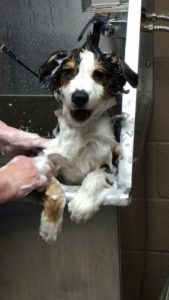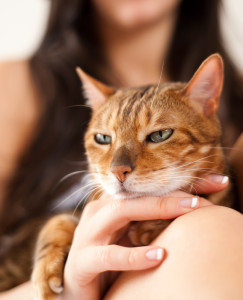Please welcome guest writer and in store Groomer, Nicole Lutz from That Groom Room, to the Petblog!
Here in That Groom Room, we often get a lot of questions regarding when is a good age to start grooming a puppy? Now that Christmas is over and many puppies were given as gifts I thought that it would be a good place to start.
At What Age Can I Start Getting My Puppy Groomed?
Officially it is best to wait until your new puppy is 8 weeks old, and can leave their mother before you consider getting them groomed. Once the puppy has been introduced to its new home and has established relations with the new owner they can think about getting the puppy groomed. That Groom Room recommends starting at 12 weeks of age. The very first grooming appointment is an introduction to the puppy and the owner to the world of grooming. The puppy with be introduced to a bath, blow drying, nail clipping, and slight trimming. We do not recommend having a puppy be given a full hair cut the first time being groomed. The reason behind this is you are forcing the puppy to stand still and be handled for 1.5 hours. This is a lot to ask of a puppy. It would be like asking a one year old child to sit without moving, going to the bathroom, or play with any toys for 45 minutes. That is why we only do the basics for puppies first groom. We bathe them, slowly dry them, trim the nails, trim the fur from around their eyes, pads, and around the sanitary area. This is about all they can handle. The puppy will be introduced to having scissors around the face, having to hold still while the pads on their feet are trimmed. Depending on how the puppy reacts to the first grooming we may recommend doing this type of trimming one more time before the full haircut. The more comfortable the puppy becomes with being handled by the groomer and being on a table, and in the tub the better the puppy will become as they grow up.
What Can You Do to Help?
It becomes more difficult to groom a puppy that is 6 months old for the first time than a 12-week-old puppy. The 6-month-old has already established fears and aggression. For example, it would be like taking a 5-year-old child and putting them in kindergarten without any discipline and experience of a pre-school and making them sit still and raise their hand when called on by the teacher. At this point in a puppy’s life if the owner has not prepped the puppy with any type of grooming; brushing, combing, or nail trimming. It makes the groomers job nearly impossible to have the puppy trust them and enjoy grooming.
All About the Training
At home grooming is also extremely essential to having a puppy become used to grooming, and to enjoy their experience at the groomers. Different types of fur require different tools. Our groomers are very willing to answer questions and show you tools that are appropriate for your puppy. One of the biggest misconceptions about puppies and grooming is when they will change from puppy coat to adult coat. This time in a puppy’s life is essential to maintain so the coat does not mat. Usually puppies get their adult coat around six months of age. The puppy coat on some breeds will not shed and becomes tangled in the adult coat if not brushed on a regular basis. Please ask one of our groomers if your puppy has started this stage in life or when this may occur in order to make the transition more comfortable.
Thank you for reading, and if you are ready for us to help you and your new puppy contact us today! You can reach us at (717) 484-9758 or by emailing us at grooming@thatpetplace.com.
 That Pet Blog That Pet Place Pet Blog
That Pet Blog That Pet Place Pet Blog



 Even cat lovers acknowledge that they can be fussy creatures and depending on the breed, it can take a lot of effort to properly groom your cat. For example, trying to groom a Persian feline can be a real challenge and in most cases, it is best to leave unwilling participants in the hands of experts! Many cat owners are guilty of delaying the grooming process and this only serves to make things worse, as their pets can suffer from matted hair and it may also be the case where certain medical conditions go unnoticed, because you did not recognize the symptoms. Below, we take a quick look at what a professional
Even cat lovers acknowledge that they can be fussy creatures and depending on the breed, it can take a lot of effort to properly groom your cat. For example, trying to groom a Persian feline can be a real challenge and in most cases, it is best to leave unwilling participants in the hands of experts! Many cat owners are guilty of delaying the grooming process and this only serves to make things worse, as their pets can suffer from matted hair and it may also be the case where certain medical conditions go unnoticed, because you did not recognize the symptoms. Below, we take a quick look at what a professional 